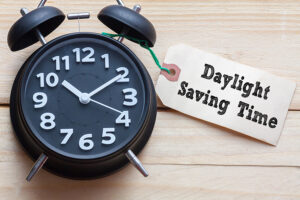How Daylight Saving Time Affects Your Health
Chances are you haven’t slept well for the past week or so. Who would after an hour shift in the amount of daylight we’re exposed to before bedtime? Daylight saving time is the practice of advancing clocks an hour in the spring to provide more daylight and longer summer evenings. Sounds like a great idea, unless you live in a time zone where the mid-summer sun is still up when you’re trying to get your kids to bed.
Every state in the US, except for Arizona and Hawaii, springs forward and falls back annually. Arizona and Hawaii are on permanent standard time, they never change. It’s a common myth that daylight saving time was first introduced in the US for the benefit of farmers. But farmers have been one of the strongest lobbying groups against daylight saving time. Factors that influence farming schedules like the morning dew and cows’ readiness to milk are ultimately dictated by the sun.

Communities in several countries around the globe first implemented the practice of moving their clocks during World War I as a means of adding more daylight hours to conserve energy. Year-round daylight saving time became common during World War II. At that time, states were free to choose when to observe daylight saving time, until 1966 when federal law standardized it with the Uniform Time Act.
Studies have linked the “spring forward” time change with an uptick in fatal car crashes, emergency room visits, missed appointments, heart attacks and strokes:
- A 2017 study in the American Economic Journal: Applied Economics estimated that the shift in the spring caused over 30 deaths at a social cost of $275 million annually, primarily by increasing sleep deprivation.
- A study published in Current Biology in 2020 found that car accident fatalities increase 6 percent during the five workdays following the spring time change.
- According to a study published in Open Heart in 2014, heart attacks jump 24 percent on the Monday after the shift to daylight saving time. The study also found that heart attacks dropped 21 percent following the fall shift to standard time.
Some members of Congress recognize the problem and are working to ban the biannual time changes. Sen. Marco Rubio has routinely introduced a bipartisan bill called the Sunshine Protection Act that would make daylight saving time permanent. Don’t get too excited about this—when the government steps in to improve our lives, they usually do more harm than good. Don’t forget what George McGovern did to make us fear fat and start eating margarine in the 70s.
Both the American Academy of Sleep Medicine and the National Sleep Foundation have advocated for the elimination of the biannual time changes. But rather than backing the push for permanent daylight saving time, these sleep experts support a shift to permanent standard time.
Daylight saving time adds an hour of sunshine at to the end of the day at the expense of an hour of sunshine in the morning. That lack of sunshine in the morning, when it’s time to wake up, causes problems with motivation, alertness, and cardiovascular rhythms.

The American Academy of Sleep Medicine published a position statement in January 2024 that year-round standard time better aligns with the natural circadian rhythm, while delayed sunlight during daylight saving time could lead to circadian misalignment. It’s more difficult to wake up and get moving when it’s still dark. It’s also hard to fall asleep when the sunlight pushes so closely to bedtime.
The scientists and the politicians (at least some) both agree that the time change needs to go, but they don’t agree on when to establish the permanent time. Standard time is better for our health because it aligns our daily routines with our circadian rhythm. Permanent daylight saving time is better for the politicians because it aligns with their wallets.
Retailers, sporting goods manufactures, and golf courses have a lot to gain from a switch to permanent daylight saving time. More daylight at the end of the day means more time for shopping and outdoor recreation. The National Retail Federation and the U.S. Chamber of Commerce have acted as lobbying giants in the push for permanent daylight saving time.
And by the way, we tried it once and it didn’t work. The U.S. adopted permanent daylight saving time for a year in 1973. The public pushed back so strongly that legislators repealed the policy a year later.
Let’s pray for the sake of our health that biannual time change goes away. Let’s also pray that the American Academy of Sleep Medicine can be influential enough to convince the government to adopt permanent standard time.
Until then, we all have to learn to adjust twice a year. And it takes us quite a while to adjust to the spring time change. A 2020 study published in Scientific Reports found that night owls take more than a week to make the adjustment to the one hour time shift. It’s very likely that most of us are still trying to adjust. And some of us will never fully adjust to the sun being up 30 minutes before we go to bed. It’s a lot more difficult to get a good night’s sleep in the spring and summer than it is in the fall and winter.
So, here are a few practical tips to help you sleep better now throughout the summer months.
- Make Your Bedroom as Dark as Possible. Keeping your sleep environment dark is critical to helping you fall asleep. Install blackout curtains and shades, turn off all night lights, and position your bed so it doesn’t face a window.
- Reduce Sources of Blue Light Before Bedtime. Household LED lights and electronics emit blue light, which suppresses melatonin secretion. Your brain produces the hormone Melatonin in response to darkness. It helps you fall and stay asleep. Any exposure to blue light 30 minutes before bedtime can make it more difficult for you to fall asleep by preventing melatonin production. Consider wearing blue light blocking glasses an hour before bedtime. Stop using all electronics 30 minutes before bedtime. Consider reading a good fiction book before going to sleep instead of watching TV.
-
 Don’t Eat Anything Three Hours Before Bedtime. If you eat a big meal (or even a small snack) before you go to bed, your body will have to digest it. Doing this extra work while you sleep will affect the quality of your sleep. And if you stop eating before bed, I guarantee you will lose weight.
Don’t Eat Anything Three Hours Before Bedtime. If you eat a big meal (or even a small snack) before you go to bed, your body will have to digest it. Doing this extra work while you sleep will affect the quality of your sleep. And if you stop eating before bed, I guarantee you will lose weight.
- Make Your Room Cold. Turn your thermostat down before you go to bed. Your body is not designed to sleep in an environment where the temperature never changes. We are built to sleep outside where the temperature cools at night and we curl up with a blanket or others to keep warm. Start by setting your thermostat to 68 degrees at bedtime, then gradually go cooler until your find your optimal sleep temperature. Mine is 67 degrees.
- Exercise, But Not Before Bed. Analysts at The Sleep Foundation looked at all the studies involving exercise and sleep. They concluded that “people who experience poor sleep are less active than those with healthy sleep cycles. People with certain sleep disorders are not as likely to exercise during the day.” Strength training and physical activity will both improve your sleep, but don’t do anything intense two hours before bedtime. Intense workouts can elevate your core temperature for at least two hours, which can keep you from falling asleep.
I hope these tips help you navigate the next few weeks (or months) of trying to adjust to daylight saving time. And if you happen to run into a senator, let them know you want to switch to permanent standard time so you can live a longer, healthier life and funnel more money into the economy long-term while reducing health care costs instead of contributing short-term financial gains in just a few summer months.
Stay Strong,
Bo Railey

